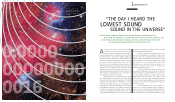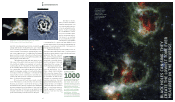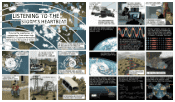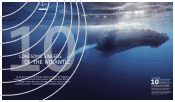Sennheiser 2011 Annual Report Download - page 17
Download and view the complete annual report
Please find page 17 of the 2011 Sennheiser annual report below. You can navigate through the pages in the report by either clicking on the pages listed below, or by using the keyword search tool below to find specific information within the annual report.
32
15 Hz
BASS SCHOOL
live, everything is Sennheiser:
all the microphones and radio
packs – everything. Since we
don’t have any monitors on
stage, we use in-ear-head-
phones from Sennheiser. The
bass player also needs to phys-
ically feel the low end of his
playing. He has a little thing
that clips underneath the stage
and vibrates the floor so that
he actually feels the bass.
Is the bass particularly important for Sade’s music?
Our records are very deep. We use a very low bass. Almost
no sub-bass, but sounds that can actually be heard and – if
you have a nice sound system – feel. For live performances,
we add sub-bass sounds; for instance, for sound effects at
the beginning of the show, when you can hear explosions
and stuff. We put 16 subwoofers on each side of the stage
so that the audience can physically feel the low tones.
When Paul [Paul Spencer Denman] plays his bass live, the
subwoofers provide a much bigger sound live than what we
use for recordings. For us, it’s essential to have a very sepa-
rate, clean, low-end bass sound.
That reminds me of the low frequencies used in movies.
Ultra-low frequencies are used in movies all the time to
evoke certain emotions. The big dramatic low bass sounds:
“Ta ta taaa…” to arouse fear. Psychoacoustics are able to
manipulate the audience. Not just sound, but the music
they hear also affects the audience. I have always been in-
terested in how to make an audience laugh or cry. Ever
since I was a little kid. You can do that with music. I am fas-
cinated by film scores that are able to impact how the audi-
ence feels about a certain character.
In pop, low bass is usually used for positive effects. What
drew you to these “feel-good low frequencies”?
When I was 18 or 19, I played in a punk rock band in the north
of England. One night, we supported the reggae group Steel
1. The Neumann KM 184s is Matthewman’s favorite
microphone. 2. Measuring just 15 square meters,
Matthewman’s studio is a very cozy space.
Pulse. I managed to get on stage when they were playing
and sat behind the drummer. He had two massive subwoof-
ers on either side of him. All we could hear were his drums
and the bass, which must have been well under 15 Hz. It was
an incredible feeling - one that completely changed my life.
The title of Sade’s album Lover’s Rock is also a reference to
a ’70s reggae genre of the same name.
You’re right. Living in London at that time, you heard reg-
gae everywhere. When I was a kid, we went to clubs that
played reggae all the time. Often, the rooms were filled just
with bass speakers and tweeters. The sound was amazing.
It was physically impossible to stand still. The bass was so
powerful that you felt sick if you stood still. You just had to
dance. The bass took you to another place completely –
physically and mentally.
Is there anyone else in Sade that likes reggae that much?
We all like very different kinds of music. Sade really likes
hip-hop; Andrew Hale, the keyboardist, likes esoteric dance
music. Paul still loves punk and I’m into film music. But, we
all love reggae. Reggae is simple; it is stripped down. The
music is about getting the soul across instead of musicians
who are showing off. You do not listen to a reggae song to
be impressed by an amazing guitar solo. What the guitarist
does is simple and it sounds RIGHT with the song. That is
exactly what we’re about. Sounding right as a band and
not showing off as musicians.
KM 184
On the studio scene, the kidney microphone has
long been considered the quality standard.
Frequency response 20 – 20,000 Hz
Directional character Kidney
Nominal impedance 50 ohms
Weight 80 g
Neumann KM184 small microphone
AUGMENTED
REALITY
























